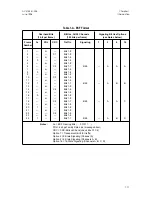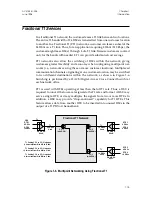
Clear Channel Capability
The primary drawback of pulse stuffing is that it corrupts the original data. This
is not a problem with voice transmissions, where the effect on the sound
reproduced at the receiving end is negligible. In data transmissions, however,
changing a single bit can have serious consequences. To eliminate the possibility
of data corruption, part of the bandwidth (for example, every eighth bit) must
be dedicated to pulses, or a method of data encoding must be employed that
ensures pulse density while allowing the entire bandwidth to be used for data.
Availability of the entire bandwidth for data is called “clear channel” capability.
The primary method for achieving clear channel capability in the T1 environ-
ment is a data-encoding scheme called B8ZS (Bipolar 8-Zero Substitution). A
modification of AMI line coding, B8ZS replaces any eight consecutive ZEROS
with a fixed code containing two bipolar violations (BPVs), as illustrated in
Figure 1-3.
There are two requirements for the use of B8ZS:
•
The CSUs or DTE at each end of the T1 link must be able to encode
and decode B8ZS.
•
Network equipment through which the signal passes must be trans-
parent to B8ZS—in other words, must not “correct” the BPVs in the
B8ZS code.
The latter requirement prevents the current implementation of B8ZS in many
T1 networks.
Framing Synchronization
T1 data is grouped into “frames” of 192 information bits plus 1 framing bit.
Framing bits occur in a fixed pattern of ONES and ZEROS. Network equipment
is able to synchronize on these patterns, and thus to identify frames properly.
An Out of Frame (OOF) event occurs whenever 5 consecutive framing bits
contain 2 or more errors.
As described in AT&T Publication 62411, a CSU declares Loss of Sync if an OOF
condition persists for at least 2.5 seconds. A CSU which loses sync on the signal
received from the T1 line declares a Red Alarm condition and transmits a
defined bit pattern called Yellow Signal to the T1 line.
ACST-0351-005
Chapter 1
June 1996
Introduction
1-7














































